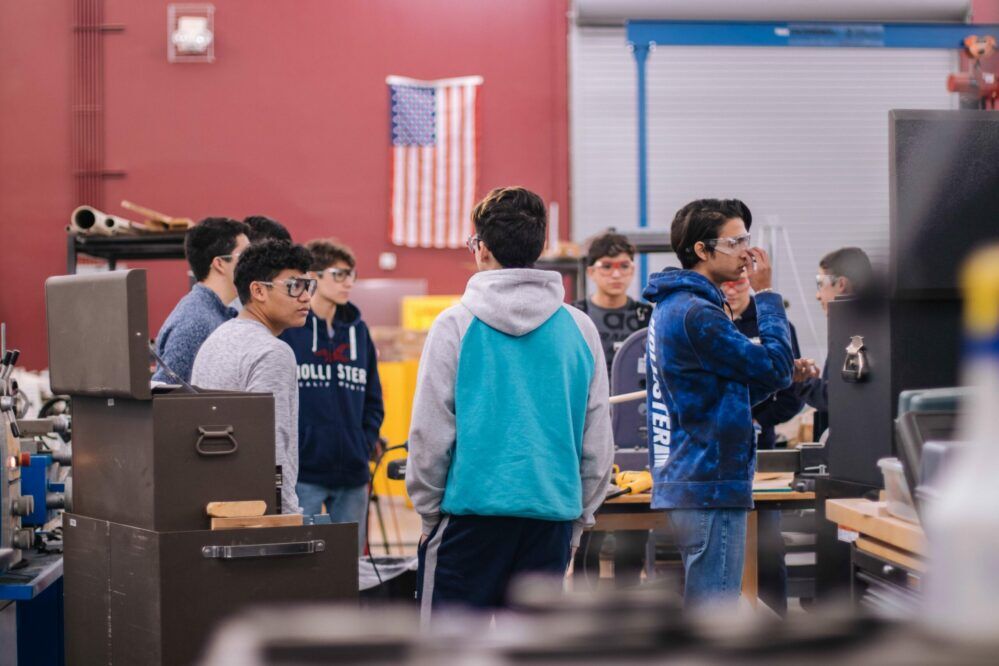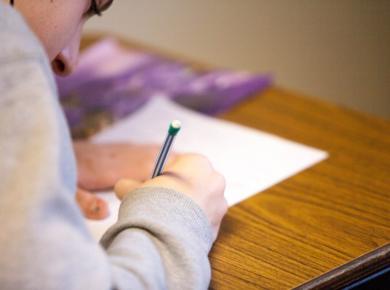Traditional face-to-face classes have served as an effective method of learning and teaching for the longest time. It has produced visible and satisfactory results and hasn’t been questioned until the world faced a common enemy, the CoVid-19 pandemic that stopped everyone from attending the traditional in-person classes.
That situation proved that technology could be sufficient and deliver the same, if not better, results in the learning process. Technology clearly impacts education in various ways. If you are curious to learn more about this impact, read this guide as it answers the question ”How does technology impact student learning?”
Use of Technology in Modern Education
In today’s day and age, technology has incorporated itself into every aspect of our lives, including the education field. It is a tool that helps us complete complex tasks quickly and efficiently.
However, it is necessary to keep in mind that technology is a tool for education, but it can’t solve the problems itself. The usefulness of educational technology lies in what educators do with it and how they use it to best meet the needs of their students.
The appropriate use of digital learning tools in the classroom can boost student engagement, assist teachers in improving lesson plans, and enable personalized learning. It also helps students to develop critical thinking skills.
Virtual classrooms, augmented reality (AR), videos, different robots, and other technology tools can not only make the class more interesting, but they can also develop more inclusive practices that foster cooperation and intellectual curiosity while also allowing teachers to collect data on student performance.
Benefits of Technology in Education
We all use technology in some form or another in our daily activities. As time passes, it has become more important in our lives, changing the way we consume and process information.
The influence of technology can be seen in every area of our lives; however, the impact of technology on education has been the most noticeable in recent years. Schools are incorporating more and more technology into the classroom to keep up with technological advances in hopes of preparing students for the rapidly changing world of technology. It has also become pivotal in helping teachers develop their teaching classes based on student’s learning styles.
Putting students’ knowledge into action
One of the most significant benefits of using technology in education is putting students’ knowledge and skills into action. Students earn beneficial knowledge through online classes and interactions with their teachers and other peer students. However, it is very important to put these new skills into practice and action.
Technology enables students to put their earned knowledge into practice through different applications. The incorporation of technology into the classroom helps teachers to easily assign various tasks and assignments that allow students to put their knowledge and experience into action and develop the ability to apply their knowledge to create a solution to a situation, problem, or event.
Sharpening students’ critical thinking
Technology will have an impact on students’ critical thinking skills depending on a variety of elements, including the type of technology used and the context in which it is used.
It is a well-known fact that the use of technology in the classroom can make activities and the learning process more engaging. Technology has the ability to engage multiple senses and can increase students’ investment in the material.
Appropriate classroom technology boosts students’ academic achievement, self-confidence, motivation in class, and attendance. Technology facilitates students’ transition from sitting attentively and listening to more hands-on learning.
In addition, technology influences critical thinking by assisting students in applying what they’ve learned to real-life situations and developing problem-solving skills, both of which are essential components of critical thinking.
Increased collaboration
Collaboration can be aided by educational technology. Teachers can communicate with students during lessons, but students can also interact with one another. Students collaborate to solve problems through online classes and educational games.
Students can share their ideas and thoughts and encourage one another in collaborative activities. Simultaneously, technology allows for one-on-one interaction with teachers. Students can ask questions about the classroom and receive additional assistance with the difficult-to-understand subject matter. Students can upload homework from home, and teachers can access and view submitted assignments on their devices.
Numerous studies have found that implementing instructional technology improves overall student motivation and engagement in learning. More specifically, technology engages students behaviorally, emotionally, and cognitively. Whether technology is used in class or after school, students have more opportunities to communicate with instructors, collaborate with peers, and participate in the learning process.
Web-conferencing software, blogs, wikis, social networking sites, and digital games are specific examples of technology that have been shown to improve student engagement and communication.
Better communication
Students can use technology to connect with people in their classrooms and around the world. Learning how to collaborate on projects using digital tools prepares students for almost any career.
Connecting with students across the globe promotes cultural learning and actually teaches how to collaborate with people who are different from them. While the internet can be an unpleasant place full of hate at times, it can provide a tremendous sense of community and support when used wisely.
Classroom websites can benefit students of all ages. They frequently foster student connections and provide a space for them to collaborate on team projects. They also help learners by instilling a sense of belonging and community in them.
Websites, which are typically filled with student work, classroom updates, and assignments, simulate the experience of being a member of an online forum or group. Students are able to gain experience designing, editing, and uploading files to the site.
Personalized learning opportunities
It has become difficult and critical to expand your skillset with hectic schedules and demanding lifestyles. This is where technology comes in. Education is more convenient than ever, with virtual lessons gradually replacing traditional lectures.
Students can plan their time and learn at a convenient time for them. They can also pursue subjects and courses outside of their course curriculum to broaden their knowledge.
Technology enables continuous access to information and knowledge. Classes can be completed entirely online using a laptop or mobile device. Learning that is hybrid combines the use of technology from almost anywhere with regular in-person classroom sessions. It is possible to use technology to tailor learning plans for each student in both scenarios. Lessons can be designed based on student interests and strengths.
Another advantage is that students can learn at their own pace. Students can rewatch videos in the lesson plan when they need to review class material to better understand key concepts. In addition, teachers can use the data generated by these online activities to see which students struggled with certain subjects and offer extra help and support.
The Impact of Technology on Student Learning
The use of technology has helped students and teachers create practical and easily-accessible teaching and learning environment.
A very important technological impact on education is increased interactivity and class engagement. In addition, better overall comprehension, practical learning, time management, and combined learning methodologies are just some of the impacts that technology has had on student learning.
Enriching the classroom with technology
✅ Request information on BAU's programs TODAY!
Choosing the right technology to incorporate into the classroom can be challenging. However, defining your learning objectives can assist you in determining which tools will be most beneficial.
It is true that not all schools can afford a one-to-one device ratio in the classroom. In situations where there are many more students than teachers, digital tools can assist in providing personalized guidance to each student. While teachers meet in private with other students, personalized digital applications can guarantee that the rest of the students are using their devices to work on their particular areas of improvement.
Better comprehension
Through the use of technology, every student basically has the world in their hands. With just a few clicks, students can easily access all the information and materials they need in order to comprehend different topics better and succeed in the process.
In certain situations, every student can face problems dealing with specific topics, and thanks to technology, this is no longer a problem since they can quickly look it up in different search engines or even ask for more explanation from their instructors. Thanks to the use of technology, instructors are always an email away, making it easier for students to connect with them and get all the necessary help.
Interactivity and class engagement
When technology is seamlessly and carefully incorporated into the classroom, students not only become more engaged but also begin to take more control over the learning process.
Effective technology integration alters the dynamics of the classroom, stimulating student-centered project-based learning. When using technology during the learning process, students are able to engage with their teachers and other students quickly and easily without wasting class time through chat rooms and other available applications.
Exploring complex matters
As mentioned previously, during the learning process, students will inevitably face obstacles and different difficulties. In addition, they may be required to explore matters that are complex and challenging for them.
However, the incorporation of technology into the learning process has made it easy for students as well as teachers to access all the materials and sources that would help to explore and solve complex matters they may encounter during the learning and teaching process.
Time-saving: effective learning
It is clear that both teachers and students make the most of what technology has to offer. One of the most significant advantages of using technology in the classroom is that it saves a lot of time.
A number of apps are available to assist teachers in taking attendance so that the task does not consume too much of their time. Even if the teacher is busy getting ready for class, students can sign their names on a tablet as they walk in.
In addition, the use of technology can completely eliminate numerous different problems; for instance, when students can access their assignments online, photocopying and stapling are no longer required.
Furthermore, with technological platforms that instantly interpret test answers on a large scale, grading is a piece of cake. Many apps provide teachers with status reports, allowing them to view each student’s progress. These reports also highlight opportunities for improvement, allowing teachers to identify learning difficulties earlier in the school year. Technology not only makes grading more accessible for teachers, but it also helps students get the help and attention they require.
Combined learning methodologies
Technology allows teachers to adapt every style of learning. Whether students learn best through listening to lectures, reading, illustrations, or recordings, technology has the ability to accommodate every type of learning that students use and prefer.
Students can learn at their convenience by using online videos, audiobooks, interactive online games, and other resources. And, because online material is typically updated, teachers and students can always get the most up-to-date information. In addition, teachers can combine different learning methodologies while using technology in order to best fit everybody’s needs.
Will Technology Prevail Over Traditional Learning?
Modern technology has completely transformed the educational system. The internet-enabled classrooms have made education available to anyone who wants to learn anywhere in the world, at any time, on any subject.
In contrast to the traditional face-to-face classrooms, which have a limited capacity of students, virtual classrooms can accommodate any number of students. And, when it comes to learning, there is an infinite amount of information available for free or at a reasonable cost.
There’s no denying that we’re becoming a more technologically oriented society. Understanding how to use technology, from digital menus to self-driving cars, helps prepare students for the future. Early learning of technology skills can help students to grow in their careers and personal lives. Therefore, whether technology will prevail over traditional learning or not, it is very beneficial for students to be up-to-date with the latest educational methods.
Final Thoughts
While education technology is generally viewed as a threat, and it does have limitations, incorporating it into your classroom practices provides students with a new way to better interact and engage with course material. Thanks to the use of technology tools, education is no longer restricted to the four walls of your classroom. The internet and social media do not have to be a source of distraction. After finding out how technology helps students learn, as a teacher, you can integrate it into lesson plans and help both yourself and students to create improved learning outcomes.















